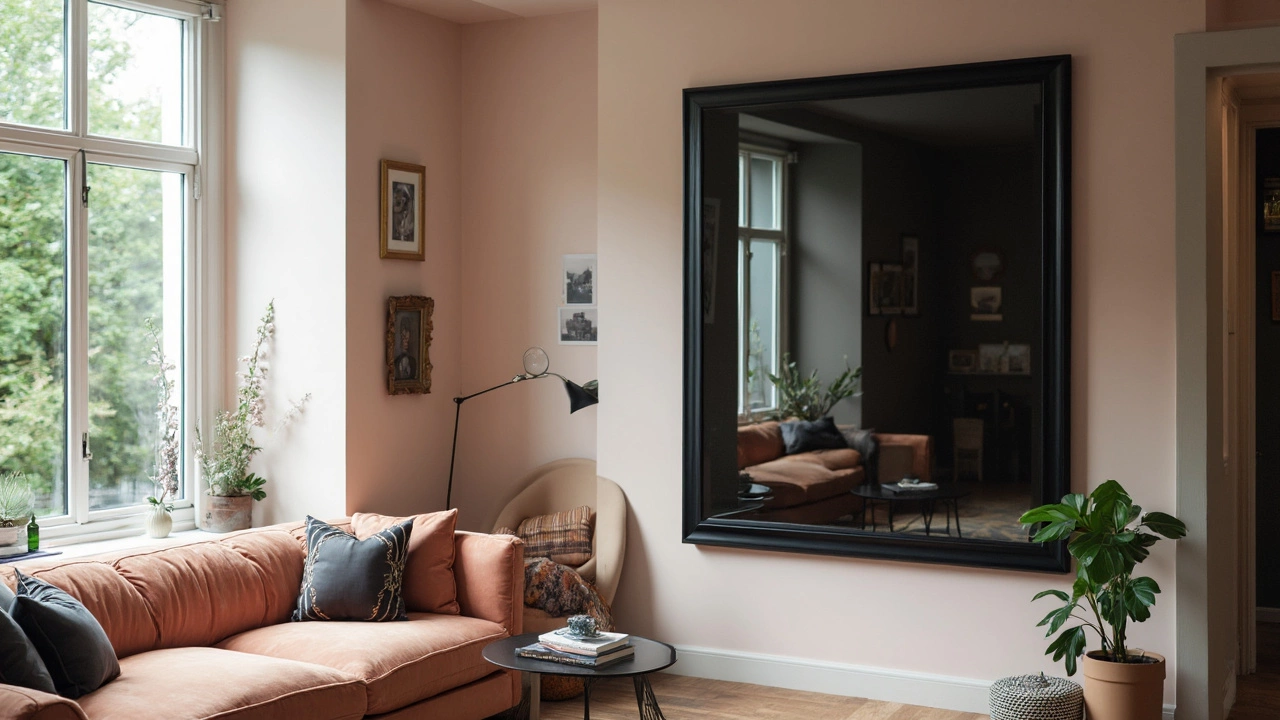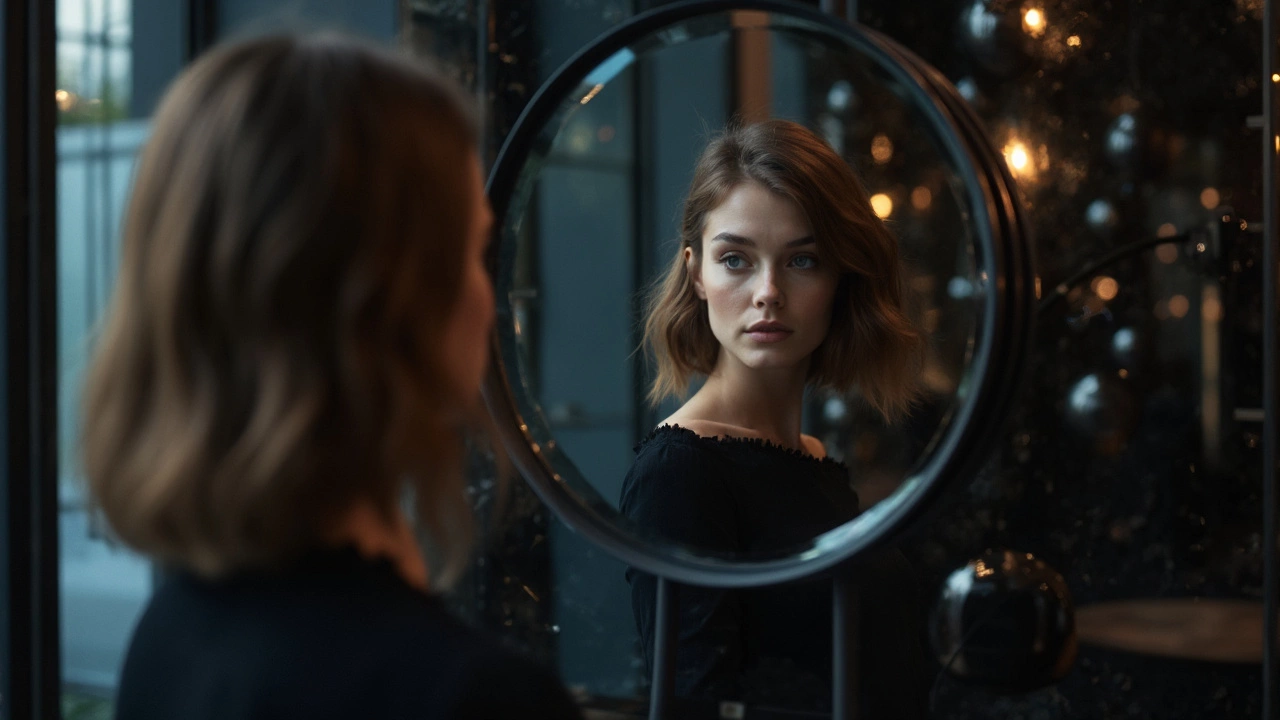Why Is Black Mirror So Popular? The Mirror Everyone’s Talking About
 Apr, 21 2025
Apr, 21 2025
Why are black mirrors all over social feeds and design blogs right now? It’s not just about looks—these mirrors are shaking up the way people see both their reflections and their spaces. Unlike regular mirrors that bounce back a clear image, black mirrors give you a dark, glossy surface that turns reflections moody and almost mystical. No wonder they’ve become such a hit among designers and collectors.
But before you start hunting for one, let’s get real about what black mirrors do. They work by using a darker backing or special glass, so the reflection isn’t bright and crystal clear. Instead, it’s softer, subtle, and gives off serious high-end vibes. If you’re someone who likes things a little different, this is the kind of statement piece that never really gets old.
- The Origins of the Black Mirror Craze
- What Makes Black Mirrors Unique?
- Practical Uses and Surprising Benefits
- Tips for Picking the Right Black Mirror
The Origins of the Black Mirror Craze
So, how did black mirrors go from being a weird curiosity to a must-have item? The story stretches back way further than most people think. Hundreds of years ago, artists and scientists actually used these dark, reflective surfaces—sometimes called “Claude glass”—for sketching and studying landscapes. They’d hold up a pocket-sized black mirror to see scenery with softer details and more dramatic shadows. It helped them focus on mood rather than detail, which was perfect for art.
Fast forward to today, and interior designers have picked up where artists left off. Black mirrors started popping up in stylish hotels and trendy places around the early 2010s. With the success of Instagram and interior design accounts, their mysterious look caught on fast. These days, you’ll spot a black mirror in everything from modern living rooms to high-end spas.
Part of the popularity comes from the fact that these mirrors are pretty different from the regular shiny stuff you see in bathrooms. People want something that sparks a conversation or stands out—especially when home trends can start to feel the same.
Here’s a quick look at where black mirrors first took off in modern design:
- 2010s: First big wave in boutique hotels, mostly in Europe and New York
- 2015–2020: Major interior magazines start highlighting black mirrors
- Today: You can order custom black mirrors online, and even big furniture stores now stock them
What Makes Black Mirrors Unique?
So what’s the deal with black mirror glass? Regular mirrors use standard silvering that bounces back almost all the light, giving you a bright, accurate reflection. Black mirrors do something different—they use smoked or black-tinted glass. This blocks out a lot of light, so the reflection is darker and looks kind of mysterious. It actually started way back in the 18th century, when artists used them to study light and shadow in their paintings.
If you stand in front of a black mirror, you’ll notice your reflection isn’t crisp. The dark surface softens lines, fading out details, which makes them perfect for mood lighting and cool Instagram shots. That darker reflection cuts down on distractions too, so they’re great for meditation spaces or anywhere you want a relaxed vibe.
For folks into interior design, these mirrors are a secret weapon. They turn any everyday wall into a dramatic backdrop. You can hang them in the entryway for a cool first impression, or use them as an eye-catching centerpiece in the living room. They fit with most decor styles—minimalist, modern, even industrial. Plus, fingerprints and dust don’t scream out at you like they do on traditional mirrors. That’s a small win right there!
- Black mirrors don’t just look cool—they’ve actually got science behind them. Their dark finish absorbs some light, instead of bouncing everything back. So, if you set one up near a window, you’ll get a more subtle, less harsh glare.
- Some artists and photographers still use black mirror surfaces (some people call them “Claude glasses”) for creative projects. They let you see color, shape, and contrast in a way a regular mirror just can’t.
If you’re into quick stats, about 20% of designers working in modern luxury spaces used some kind of black mirror or smoked glass in their 2024 projects, according to a well-known home trends report. Not just hype—these things are actually usable and stylish.

Practical Uses and Surprising Benefits
People don’t just buy a black mirror for looks. These mirrors are actually handy in ways you might not expect. For starters, artists and designers lean on black mirrors to check out lighting, color, and symmetry in their work. Since the reflection is toned down, it helps spot contrasts and messy spots way better than a regular mirror.
In tech circles, you’ll sometimes see black mirrors used for screen and display testing because the glossy, dark surface can reveal flaws, fingerprints, and smudges faster than a shiny silver mirror. Some photographers even keep a small black mirror nearby to check light balance before they shoot. Crazy, right?
The black mirror trend isn’t just about function, though. There’s a definite mood factor. Putting one of these up at home can make a room look more dramatic. Designers love using black mirrors in entryways or over fireplaces because they turn reflections into something moody, almost like modern art. If you’ve got a messy room or you don’t want to see every detail, these mirrors play it cool by hiding clutter in the reflection, making a space look tidier in seconds.
- Privacy: The darker glass means you don’t see a full-on reflection, so it’s great if you want more privacy. Some salons use black mirrors between hair stations for this exact reason.
- Decoration: These mirrors fit almost any style, from industrial to ultra-modern. They’ve even started popping up in hotels, restaurants, and upgraded home gyms.
- Easy Maintenance: Smudges and fingerprints don’t jump out as much on a black mirror as on a standard one. You’ll spend less time cleaning and less time stressing about streaks.
Check out this quick side-by-side comparison to see why folks are making the switch:
| Feature | Standard Mirror | Black Mirror |
|---|---|---|
| Reflection Clarity | Very clear | Subtle, muted |
| Fingerprint Visibility | High | Lower |
| Aesthetic Impact | Neutral | Modern, bold |
| Helps Hide Clutter | No | Yes |
If you’re looking for something more than just a mirror, a black mirror adds style, privacy, and some surprising benefits that you’ll actually notice day to day.
Tips for Picking the Right Black Mirror
Choosing a black mirror isn’t like grabbing a regular mirror off the shelf. If you want yours to look good and actually do what you want, there are a few things to watch for.
- Size and Shape: First up, size really matters. Big black mirrors have this crazy ability to make a space feel larger and more dramatic, but they can take over a room if you’re not careful. Smaller ones work better for subtle accents. Round mirrors can soften sharp corners, while rectangular ones come across modern and bold.
- Material and Quality: Not all black mirrors are equal. The best ones use real obsidian glass or high-quality tinted glass with a true black backing layer. Lower-end versions often look grayish and lose that deep, almost mysterious effect people want.
- Placement: Location changes everything. In living rooms, black mirrors double as conversation starters. Placing one opposite a window gives you a softer, moodier take on outdoor light. In hallways, they work more like a piece of modern art than just something to check your hair in.
- Frame Choices: Frames set the whole vibe. A thin black metal frame adds a modern touch, while wood surrounds can make the mirror warmer. No frame? Totally possible, but expect dust to show up faster.
- Purpose: Ask yourself—are you after the look, the history, or functionality? Some folks use black mirrors for meditation or low-key viewing gadgets. Others just want them for aesthetics. Know what you want before you buy, so you don’t get stuck with a fancy wall ornament you never use.
If you like comparing details before buying, here’s a look at popular black mirror types:
| Type | Main Feature | Common Use |
|---|---|---|
| Obsidian | True natural glass, deep black | Spiritual, decorative |
| Tinted Glass | Affordable, industrial feel | Modern décor |
| Acrylic | Lightweight, less fragile | Kids’ rooms, easy move |
Another quick tip: Pay attention to care instructions. Most black mirrors show fingerprints and dust faster than your old bathroom mirror. Microfiber cloths work best—skip old paper towels since they can leave streaks.
Looking for that high-end designer pop without dropping a fortune? Even a small black mirror, carefully placed, stands out. Don’t overdo it, just match with your style and you’re golden.